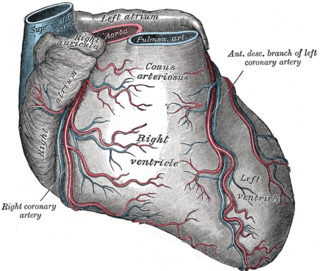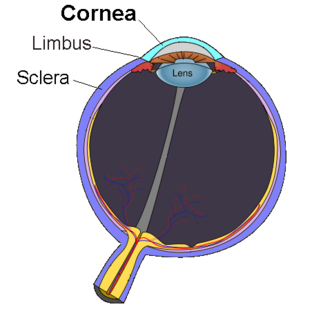
Angina, also known as angina pectoris, is chest pain or pressure, usually due to not enough blood flow to the heart muscle.

Coronary artery bypass surgery, also known as coronary artery bypass graft surgery, and colloquially heart bypass or bypass surgery, is a surgical procedure to restore normal blood flow to an obstructed coronary artery. A normal coronary artery transports blood to and from the heart muscle itself, not through the main circulatory system.

The coronary arteries are the arteries of the coronary circulation, which transports blood into and out of the cardiac muscle. They are mainly composed of the left and right coronary arteries, both of which give off branches. Coronary arteries can also be categorized as epicardial and microvascular.

Interventional cardiology is a branch of cardiology that deals specifically with the catheter based treatment of structural heart diseases. Andreas Gruentzig is considered the father of interventional cardiology after the development of angioplasty by interventional radiologist Charles Dotter.
Coronary thrombosis is the formation of a blood clot inside a blood vessel of the heart. This blood clot restricts blood flow within the heart. It is associated with narrowing of blood vessels subsequent to clotting. The condition is considered as a type of ischaemic heart disease.

Cardiac catheterization is the insertion of a catheter into a chamber or vessel of the heart. This is done both for diagnostic and interventional purposes. A common example of cardiac catheterization is coronary catheterization that involves catheterization of the coronary arteries for coronary artery disease and myocardial infarctions. Catheterization is most often performed in special laboratories with fluoroscopy and highly maneuverable tables. These "cath labs" are often equipped with cabinets of catheters, stents, balloons, etc of various sizes to increase efficiency. Monitors show the fluoroscopy imaging, EKG, pressure waves, and more.

The left coronary artery is an artery that arises from the aorta above the left cusp of the aortic valve and feeds blood to the left side of the heart. It is also known as the left main coronary artery and the left main stem coronary artery. It is one of the coronary arteries.

The coronary sinus is a collection of veins joined together to form a large vessel that collects blood from the heart muscle (myocardium). It delivers less-oxygenated blood to the right atrium, as do the superior and inferior vena cavae. It is present in all mammals, including humans.
Variant angina, often termed Prinzmetal's angina, Prinzmetal angina, and less commonly vasospastic angina, angina inversa, coronary vessel spasm, or coronary artery vasospasm, is a syndrome typically consisting of angina that unlike classical angina, which is triggered by exertion or exercise, commonly occurs in individuals at rest or even asleep. It is caused by vasospasm, a narrowing of the coronary arteries due to contraction of the smooth muscle tissue in the vessel walls. This contrasts with classical angina which is due to the permanent occlusion of these vessels by atherosclerosis.
A vascular bypass is a surgical procedure performed to redirect blood flow from one area to another by reconnecting blood vessels. Often, this is done to bypass around a diseased artery, from an area of normal blood flow to another relatively normal area. It is commonly performed due to inadequate blood flow (ischemia) caused by atherosclerosis, as a part of organ transplantation, or for vascular access in hemodialysis. In general, someone's own vein (autograft) is the preferred graft material for a vascular bypass, but other types of grafts such as polytetrafluoroethylene (Teflon), polyethylene terephthalate (Dacron), or a different person's vein (allograft) are also commonly used. Arteries can also serve as vascular grafts. A surgeon sews the graft to the source and target vessels by hand using surgical suture, creating a surgical anastomosis.

Percutaneous coronary intervention (PCI) is a non-surgical procedure used to treat narrowing (stenosis) of the coronary arteries of the heart found in coronary artery disease. After accessing the blood stream through the femoral or radial artery, the procedure uses coronary catheterization to visualise the blood vessels on X-ray imaging. After this, an interventional cardiologist can perform a coronary angioplasty, using a balloon catheter in which a deflated balloon is advanced into the obstructed artery and inflated to relieve the narrowing; certain devices such as stents can be deployed to keep the blood vessel open. Various other procedures can also be performed.
A circulatory anastomosis is a connection between two blood vessels, such as between arteries, between veins or between an artery and a vein. Anastomoses between arteries and between veins result in a multitude of arteries and veins, respectively, serving the same volume of tissue. Such anastomoses occur normally in the body in the circulatory system, serving as backup routes for blood to flow if one link is blocked or otherwise compromised, but may also occur pathologically.

The left anterior descending artery is a branch of the left coronary artery. Occlusion of this artery is often called the widow-maker infarction due to a high death risk.
Minimally Invasive Direct Coronary Artery Bypass (MIDCAB) is a surgical treatment for coronary heart disease that is a less invasive method of coronary artery bypass surgery (CABG). MIDCAB gains surgical access to the heart with a smaller incision than other types of CABG. MIDCAB is sometimes referred to as "keyhole" heart surgery because the operation is analogous to operating through a keyhole.
A coronary CT calcium scan is a computed tomography (CT) scan of the heart for the assessment of severity of coronary artery disease. Specifically, it looks for calcium deposits in the coronary arteries that can narrow arteries and increase the risk of heart attack. This severity can be presented as Agatston score or coronary artery calcium (CAC) score. The CAC score is an independent marker of risk for cardiac events, cardiac mortality, and all-cause mortality. In addition, it provides additional prognostic information to other cardiovascular risk markers. A typical coronary CT calcium scan is done without the use of radiocontrast, but it can possibly be done from contrast-enhanced images as well, such as in coronary CT angiography.

A coronary stent is a tube-shaped device placed in the coronary arteries that supply blood to the heart, to keep the arteries open in the treatment of coronary heart disease. It is used in a procedure called percutaneous coronary intervention (PCI). Coronary stents are now used in more than 90% of PCI procedures. Stents reduce angina and have been shown to improve survivability and decrease adverse events in an acute myocardial infarction.
A spontaneous coronary artery dissection (SCAD) is a rare, sometimes fatal traumatic condition, with eighty percent of cases affecting women. One of the coronary arteries develops a tear, causing blood to flow between the layers which forces them apart. Studies of the disease place the mortality rate at around 70%.













